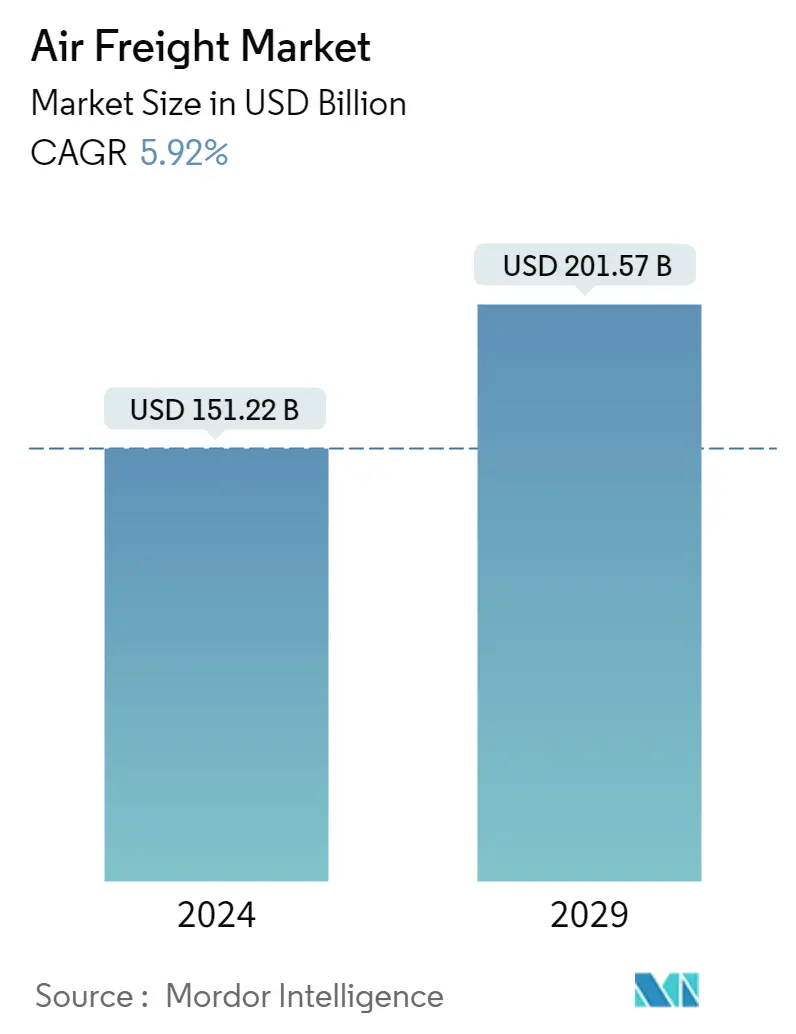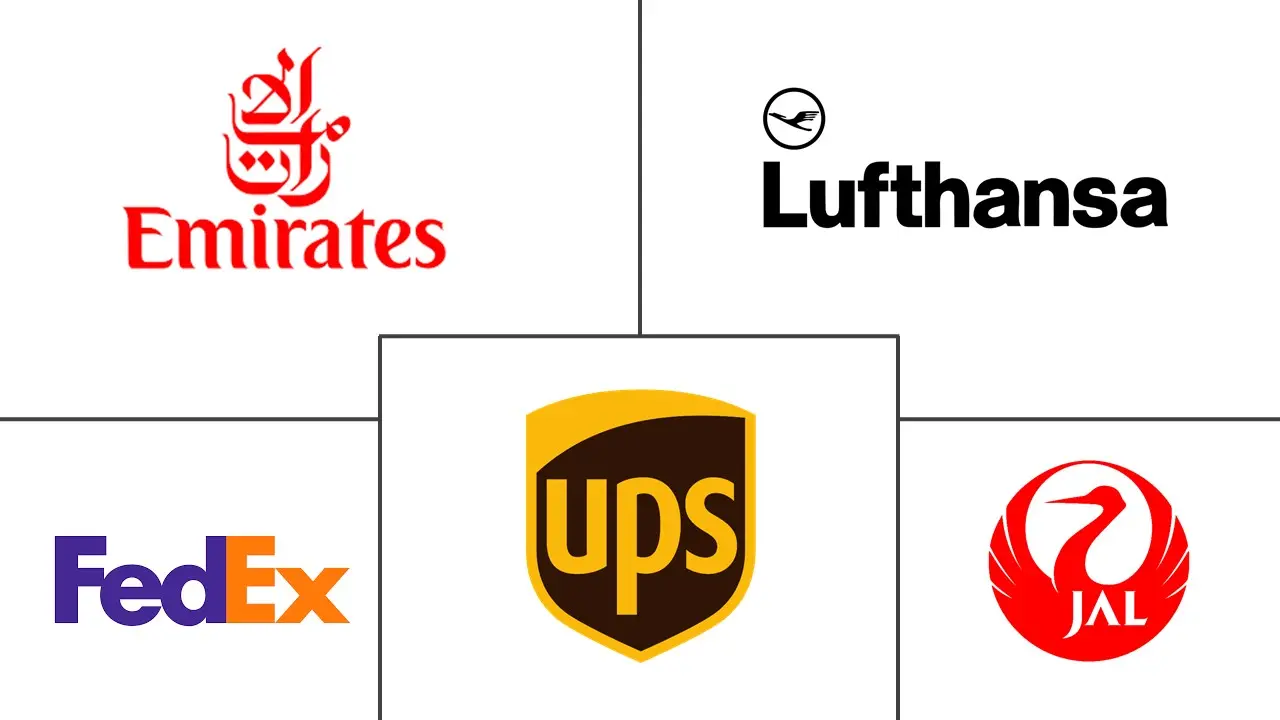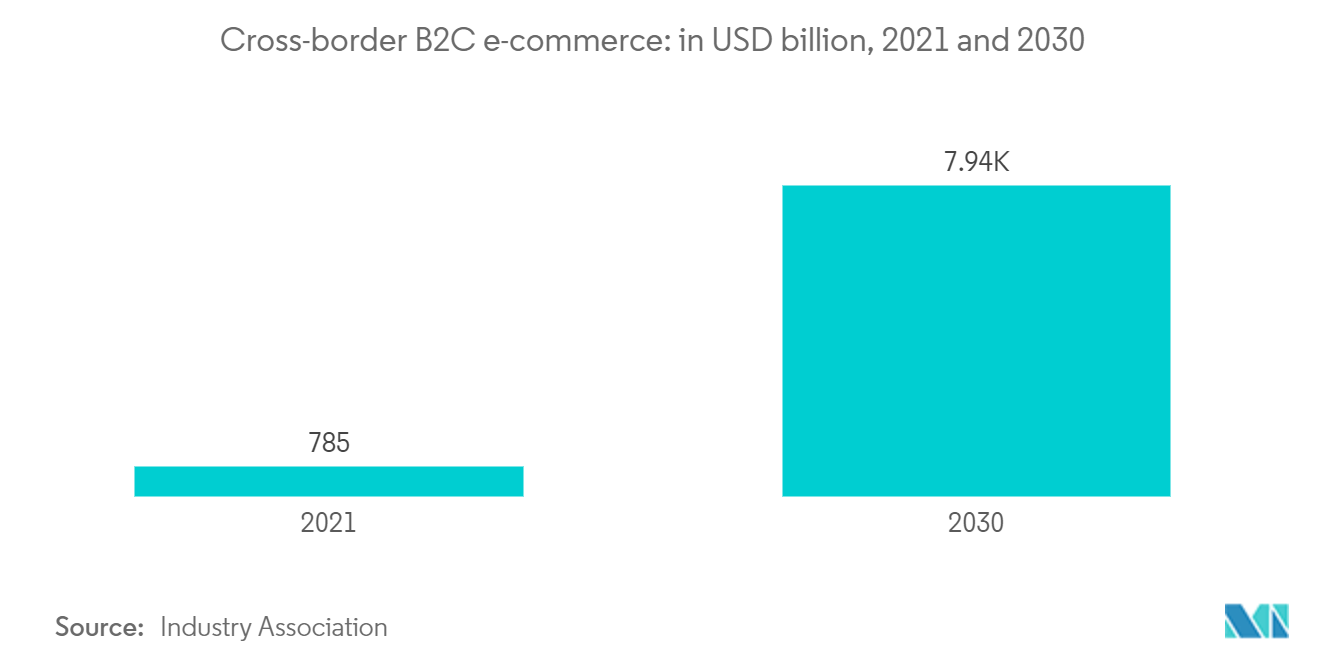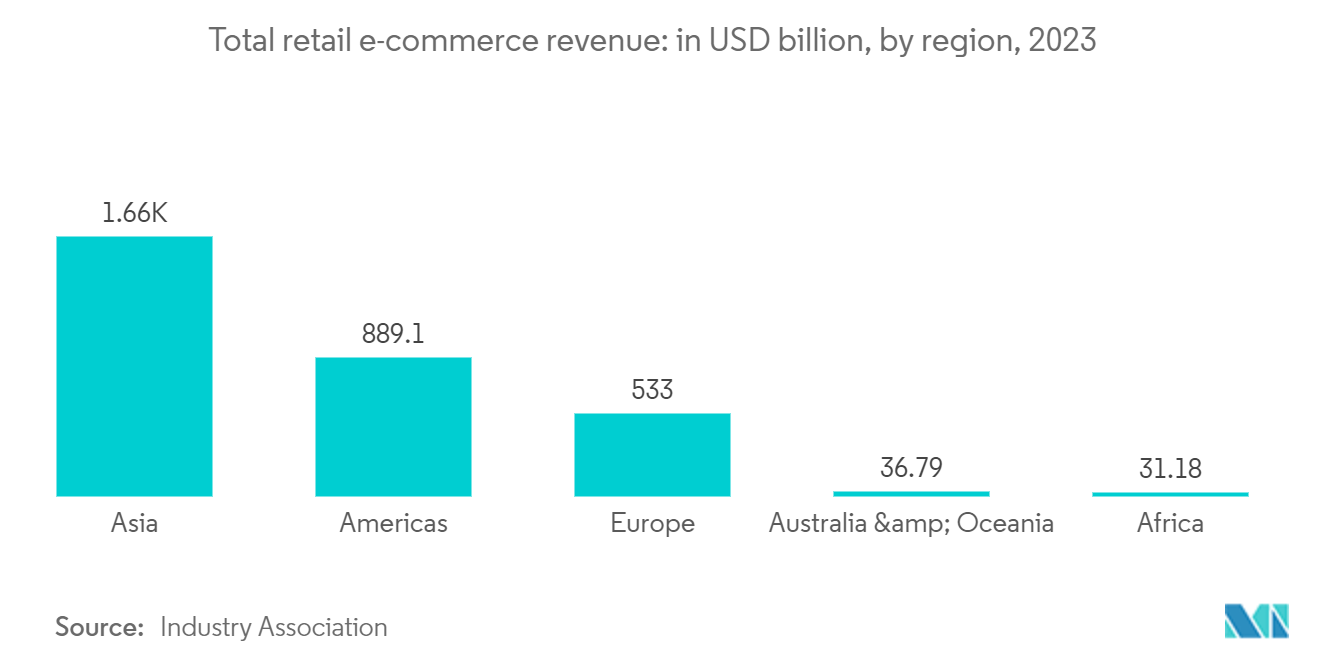Air Freight Market Size

| Study Period | 2019 - 2029 |
| Market Size (2024) | USD 151.22 Billion |
| Market Size (2029) | USD 201.57 Billion |
| CAGR (2024 - 2029) | 5.92 % |
| Fastest Growing Market | Middle-East and Africa |
| Largest Market | Asia-Pacific |
Major Players
*Disclaimer: Major Players sorted in no particular order |
Need a report that reflects how COVID-19 has impacted this market and its growth?
Air Freight Market Analysis
The Air Freight Market size is estimated at USD 151.22 billion in 2024, and is expected to reach USD 201.57 billion by 2029, growing at a CAGR of 5.92% during the forecast period (2024-2029).
The air cargo industry faced considerable challenges in 2022, mainly due to the ongoing dispute between Russia and Ukraine, significantly reducing the volume of dedicated air cargo originating in Russia.
According to the International Air Transport Association, in July 2023, the air cargo industry experienced a 20.7% increase from the previous month, maintaining steady growth since February 2023. However, compared to July 2022, the industry's cargo tonne kilometers (CTKs) decreased by 0.8%, placing it 0.3% below the July 2022 level and 3.7% lower than the pre-crisis level in 2019.
Airlines demonstrated remarkable innovation and agility throughout the historical shock of the pandemic, displaying resilience during this period. The financial profitability of airlines is within reach of the industry at large despite continued pressure on cost evolution from the macroeconomic environment. Unlike other sectors, the substantial gap between jet fuel and oil prices limits airlines' ability to benefit from potential oil price declines. There was a persistent problem until 2023 due to the limited capacity of refineries. Tight labor markets direct to higher wages and unsustainable pricing power within the downstream aviation value chain were likely to persist in 2023.
This version aims to enhance readability by breaking down some sentences and rephrasing certain parts for better flow while maintaining the original context and information.
Air Freight Market Trends
Growing Demand For The Air Freight Market
The air cargo industry is the backbone of global trade, facilitating the transportation of goods and interconnecting companies worldwide. In recent years, there has been a dramatic surge in air cargo due to the growth of the global economy, evolving consumer preferences, and technological advancements. Cross-border trade is the primary driver behind the current market growth, which is expected to accelerate further in the coming years. The demand for swift and efficient international shipping intensifies as global trade escalates.
In August 2023, China's Shenzhen Bao'an International Airport (SBI) experienced a twofold increase in cross-border e-commerce from January to July, anticipating further growth in the remaining five months after including freighter flights in the airport's operations. SBI successfully managed 93,000 tons of international e-commerce in seven months, marking a 101% increase compared to last year.
Partner airlines Central Airlines and YunExpress introduced a second Boeing 777 freight flight in late July, a move anticipated to bolster cargo volumes significantly. This additional freighter aims to expand the airlines' service from three to six weekly flights connecting Shenzhen and Paris.
April 2023 witnessed the introduction of new features in digital air cargo marketplaces, allowing logistics companies overseeing imports to promptly book export shipments from agents in other countries. This development eliminates the previously time-consuming process of sourcing quotes via phone or email.
Cargo.One announced an upgrade targeting easier booking for freight forwarders seeking overseas bookings with partners, eliminating the need for a third party to execute the booking.
WebCargo, a part of the Freightos companies, disclosed that air freight wholesale distributors in China can now sell space directly to freight agents, akin to airline partners.
Third-party platforms, exemplified by CargoAi, enable airlines to vend their capacity in a unified platform, empowering forwarders to compare live rates and availability while electronically booking shipments, similar to how travelers shop for air seats, hotels, and rental cars online using platforms like Kayak and Priceline.

E-commerce Growth Creating Great Opportunities For The Air Freight Industry
The explosive surge of e-commerce during the pandemic rendered its future trajectory unpredictable. This online shopping phenomenon has become a global norm as consumers worldwide embrace the convenience of digital transactions. IATA reports that 80% of international e-commerce relies on air transport, significantly streamlining cross-border shopping with enhanced efficiency, security, and transparency. Projections anticipate a substantial expansion in the e-commerce sector, potentially soaring to USD 4.4 trillion by 2026.
Logistics, widespread mobile device ownership, and marketplace expansions are pivotal factors that fuel this anticipated growth. Moreover, this expansion is not confined solely to new regions but encompasses areas where online shopping has already entrenched itself, underscoring the crucial role of logistics. The air cargo industry, boasting global networks, adaptable capacity, and digitalization initiatives, stands well-equipped to bolster e-commerce growth. These initiatives promise to augment operational efficiency and shipment visibility throughout transit.
As the global e-commerce landscape burgeons, strategic partnerships, cutting-edge technologies, and robust infrastructures will dominate the air cargo arena, ensuring visibility, flexibility, and swiftness at each journey stage. Delta Cargo announced in February 2024 that it launched a new product called DeliverDirect, developed jointly with SmartKargo. With various service innovations enabling customers to modify their preferences, the DeliverDirect offer can meet shippers' specific needs.

Air Freight Industry Overview
The air freight industry is moderately fragmented, with dominant players operating across multiple regions worldwide. The increasing demand for air freight transportation services presents new challenges to cargo providers. Airlines must prioritize implementing fuel-efficient solutions and embracing innovative technologies to offer cost-effective services.
For instance, companies like Lufthansa Cargo have invested in digital capabilities, such as their e-booking system, and aim to make their booking systems accessible through Application Programming Interfaces (APIs), providing inventory accessibility to others.
However, regulatory disputes (such as the US-China trade war), anti-national activities, and the COVID-19 pandemic significantly disrupted the air freight industry. This disruption led to the cancellation of numerous flights due to safety concerns and a decrease in passenger numbers.
To support the warehousing requirements of goods transported through airports, special economic zones (SEZs), free trade zones (FTZs), and bonded warehouses are expected to play a crucial role.
Air Freight Market Leaders
FedEx (Federal Express) Corporation
United Parcel Service Inc.
The Emirates Group
Cathay Pacific Airways Limited
Cargolux Airlines International Sa
*Disclaimer: Major Players sorted in no particular order

Air Freight Market News
December 2023: Aerovision Technology Limited, ATL, and Hong Kong Air Cargo Terminals Limited agreed to install ATL's proprietary intelligent cargo temperature detection system in appropriate locations within Hactl's SuperTerminal 1. To cope with the increasing volume of hazardous air cargo and to mitigate the risk of fire, it will further enhance the safety and reliability of cargo inspections.
October 2023: A new cargo development agreement, doubling the capacity between China and Bournemouth, signed by Cargo First, the air freight business at Bournemouth Airport. The service is provided by European Cargo, based in Bournemouth, using its fleet of 76-tonne A-340 all-cargo freighters.
May 2023: FedEx launched FedEx Sustainability Insights for customer emissions tracking. This cloud-based engine uses near-real-time FedEx network data to estimate CO2e emissions for individual tracking numbers and FedEx.com accounts.
May 2023: FedEx Express improved its international delivery services to cater to customers' increasing demand for dependable and diverse services in Asia-Pacific. Customers can now access FedEx International Economy (IE) services connecting Asia-Pacific to 170 markets worldwide.
Air Freight Market Report - Table of Contents
1. INTRODUCTION
1.1 Study Deliverables
1.2 Study Assumptions
1.3 Scope of the Study
2. RESEARCH METHODOLOGY
3. EXECUTIVE SUMMARY
4. MARKET INSIGHTS
4.1 Market Overview
4.2 Industry Policies and Regulations
4.3 Technology Snapshot and Digital Trends
4.4 Value Chain / Supply Chain Analysis
4.5 Elaboration on Air Freight Rates
4.6 Spotlight on Heavy Cargo/Project Logistics in the Air Cargo Industry
4.7 Insights into Key Ground Handling Equipment in Airports
4.8 Review and Commentary on Standards and Regulations on the Safe Transport of Dangerous Goods
4.9 Brief on Cold Chain Logistics in the Air Cargo Sector
5. MARKET DYNAMICS
5.1 Market Drivers
5.1.1 Increasing Global Trade
5.1.2 Growth of E-commerce
5.2 Market Restraints
5.2.1 High Operational Costs
5.2.2 Capacity Constraints
5.3 Market Opportunities
5.3.1 Increasing Demand for Perishable Goods
5.3.2 The Emergence of New Markets on the Globe
5.4 Industry Attractiveness - Porter's Five Forces Analysis
5.4.1 Threat of New Entrants
5.4.2 Bargaining Power of Buyers/Consumers
5.4.3 Bargaining Power of Suppliers
5.4.4 Threat of Substitute Products
5.4.5 Intensity of Competitive Rivalry
6. MARKET SEGMENTATION
6.1 By Service
6.1.1 Forwarding
6.1.2 Airlines
6.1.3 Mail
6.2 By Destination
6.2.1 Domestic
6.2.2 International
6.3 By Carrier Type
6.3.1 Belly Cargo
6.3.2 Freighter
6.4 By Geography
6.4.1 Asia-Pacific
6.4.1.1 China
6.4.1.2 Japan
6.4.1.3 India
6.4.1.4 South Korea
6.4.1.5 Rest of Asia-Pacific
6.4.2 North America
6.4.2.1 United States
6.4.2.2 Canada
6.4.3 Europe
6.4.3.1 United Kingdom
6.4.3.2 Germany
6.4.3.3 France
6.4.3.4 Russia
6.4.3.5 Rest of Europe
6.4.4 Middle East and Africa
6.4.4.1 Saudi Arabia
6.4.4.2 United Arab Emirates
6.4.4.3 Qatar
6.4.4.4 South Africa
6.4.4.5 Rest of Middle East and Africa
6.4.5 Latin America
6.4.5.1 Brazil
6.4.5.2 Mexico
6.4.5.3 Argentina
6.4.5.4 Colombia
6.4.5.5 Rest of Latin America
7. COMPETITIVE LANDSCAPE
7.1 Market Concentration Overview
7.2 Company Profiles
7.2.1 FedEx (Federal Express) Corporation
7.2.2 The Emirates Group
7.2.3 Cathay Pacific Airways Limited
7.2.4 Cargolux Airlines International SA
7.2.5 China Airlines Ltd
7.2.6 Japan Airlines Co. Ltd
7.2.7 Qatar Airways Company QCSC
7.2.8 Deutsche Lufthansa AG
7.2.9 All Nippon Airways Co. Ltd (ANA)
7.2.10 International Consolidated Airlines Group SA
7.2.11 Magma Aviation Limited
7.2.12 Deutsche Post DHL
7.2.13 United Airlines
7.2.14 American Airlines
7.2.15 Delta Airlines
7.2.16 Gol Airlines
7.2.17 Azul Airlines
7.2.18 LATAM Airlines
7.2.19 Copa Airlines
7.2.20 AirBridgeCargo Airlines
7.2.21 Cargojet Inc.*
- *List Not Exhaustive
7.3 Other Companies
8. MARKET OPPORTUNITIES AND FUTURE TRENDS
9. APPENDIX
9.1 Macroeconomic Indicators (GDP Distribution, by Activity, Contribution of the Transport and Storage Sector to Economy)
9.2 External Trade Statistics - Exports and Imports, by Product
9.3 Insights into the Key Export Destinations and Import Origin Countries
Air Freight Industry Segmentation
Air freight transport refers to transporting goods by air from one place to another. These services are commonly used for shipments of goods that require quick and effective delivery, particularly over long distances or internationally. Compared to different modes of transport, such as sea or land, air freight has a reputation for speed and reliability.
A detailed analysis of the air cargo market, covering current trends, limitations, and technological advancements, along with comprehensive information on various segments and industry competition, is covered in the report. The impact of COVID-19 has also been incorporated and considered during the study.
The global air freight market is segmented by service (forwarding, airlines, and mail), destination (domestic and international), carrier type (belly cargo and freighter), and geography (Asia-Pacific, North America, Europe, Middle East and Africa, and Latin America). The report offers market size and forecasts for all the above segments in value (USD).
| By Service | |
| Forwarding | |
| Airlines | |
| By Destination | |
| Domestic | |
| International |
| By Carrier Type | |
| Belly Cargo | |
| Freighter |
| By Geography | |||||||
| |||||||
| |||||||
| |||||||
| |||||||
|
Air Freight Market Research Faqs
How big is the Air Freight Market?
The Air Freight Market size is expected to reach USD 151.22 billion in 2024 and grow at a CAGR of 5.92% to reach USD 201.57 billion by 2029.
What is the current Air Freight Market size?
In 2024, the Air Freight Market size is expected to reach USD 151.22 billion.
Who are the key players in Air Freight Market?
FedEx (Federal Express) Corporation, United Parcel Service Inc., The Emirates Group, Cathay Pacific Airways Limited and Cargolux Airlines International Sa are the major companies operating in the Air Freight Market.
Which is the fastest growing region in Air Freight Market?
Middle-East and Africa is estimated to grow at the highest CAGR over the forecast period (2024-2029).
Which region has the biggest share in Air Freight Market?
In 2024, the Asia-Pacific accounts for the largest market share in Air Freight Market.
What years does this Air Freight Market cover, and what was the market size in 2023?
In 2023, the Air Freight Market size was estimated at USD 142.27 billion. The report covers the Air Freight Market historical market size for years: 2019, 2020, 2021, 2022 and 2023. The report also forecasts the Air Freight Market size for years: 2024, 2025, 2026, 2027, 2028 and 2029.
What is the impact of e-commerce on the Air Freight Market?
E-commerce has had a significant and transformative impact on the Air Freight Market, acting as a major driver of its growth and shaping its future landscape.
What are the upcoming trends in the Air Freight Industry?
The upcoming trends in the Air Freight Industry are A) The growing utilization of Artificial Intelligence and Machine Learning tools to enhance logistics and supply chain operations b) Growing demand for swift and efficient international shipping intensifies
Air Freight Industry Report
The global air freight market, as analyzed by Mordor Intelligence™ Industry Reports, is projected to experience significant growth. This growth is attributed to the increasing demand for efficient and fast transportation of goods across borders, significant growth in the e-commerce industry, and rising import and export of goods among numerous countries worldwide. The market is undergoing a technological transformation, evolving from the excessive usage of old mainframe systems to more adaptable interfaces employed for various processes. The rising usage of cool-chain tech, robotics, automated systems, artificial intelligence (AI), Big Data, deep learning, IoT, and augmented and virtual reality across several operations is anticipated to boost the market growth. However, high costs associated with air freight solutions may hinder this growth. The market segmentation is based on service, destination, end-use, and region, with the service segment divided into freight, express, mail, and other services. Depending on the destination, the market is bifurcated into domestic and international, and by end-use, it is fragmented into private and commercial. A sample of this industry analysis is available as a free report PDF download, providing a historical overview and a market forecast outlook.
